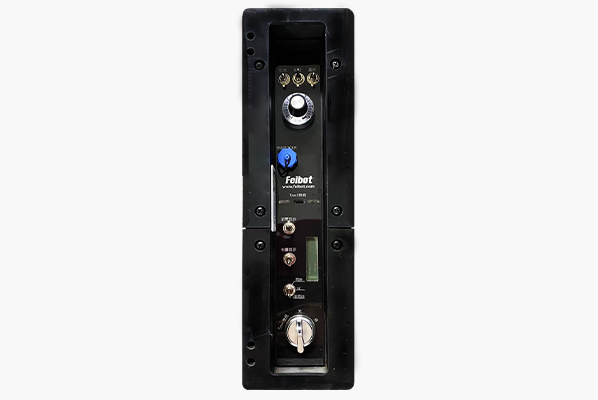Note
The switches on the side control panel are all toggle switches. Except for the synchronization toggle switch, which is a three-position switch, all other toggle switches are two-position switches. The two-position toggle switches are turned on when the rocker is facing up and turned off when the rocker is facing down. The three-position toggle switch is turned on when the rocker is facing up, turned off when the rocker is in the middle position, and turned on again when the rocker is facing down. The specific features of each toggle switch are as follows:
1. Top three toggle switches (R, G, B) on the side control panel: These switches control the color of the clock, with 6 adjustable colors: red, green, blue, yellow, purple, and cyan.
| Toggle switch R | Toggle switch G | Toggle switch B | Color |
| ↑ | ↓ | ↓ | red |
| ↓ | ↑ | ↓ | green |
| ↓ | ↓ | ↑ | blue |
| ↑ | ↑ | ↓ | yellow |
| ↑ | ↑ | ↑ | yellow |
| ↓ | ↓ | ↓ | yellow |
| ↑ | ↓ | ↑ | purple |
| ↓ | ↑ | ↑ | cyan |
2. This knob adjusts the brightness of the clock. The brightness has 11 levels: 0%, 10%, 20%...100%. The 0 position is the minimum brightness, and the other positions increase the brightness as the value increases.
Note
It is recommended to rotate the brightness knob to align with the percentage markings to avoid sudden changes in brightness.
3. The score display is connected to the score sensing board to show the score.
4. Front zero display toggle switch controls whether the front zero display is shown. When the toggle is facing up, the front zero is displayed. When the toggle is facing down, the front zero is not displayed. In this state, only the second digits and a small dot are lit on the display. As the timer progresses, the minute and hour digits light up sequentially. The purpose of this design is to save power.
5. Battery display toggle switch controls whether the battery display module is active. When the toggle is facing up, the battery level is displayed. When the toggle is facing down, the battery display is turned off.
6. Synchronization toggle switch controls whether the clock synchronizes with other clocks. It requires synchronization lines to be connected to another clock. The synchronization toggle switch has three positions: when the toggle is facing up, the synchronization feature is enabled, and an external driving signal is required to work; when the toggle is in the middle position, the clock is off; when the toggle is facing down, the clock uses its own driving signal to operate.
Note
The concept of synchronization here refers to making the time displayed on two clocks completely synchronized, with no deviation. The application scenario is when both clocks need to display the time simultaneously. The original intention of designing the synchronization feature is to ensure that the time on both clocks is fully synchronized. When the synchronization feature is activated, the signal from one clock directly feeds into the other clock, ensuring that there will be no time deviation as the time increases. Therefore, when synchronization is not needed, make sure the synchronization toggle switch is in the down position to keep the clock in normal working mode.
7. There are three states for key lock switch: on, off, and charging. When the key is turned to the charging position, a Type C charger can be used to charge the clock.
Note
When the clock is in normal operation, do not use a Type C charger to charge it. Ensure the key is turned to the switch lock charging position before using the Type C charger. The clock only supports Type C chargers with PD fast charging. It is recommended to use a charger with a power rating greater than 60W for optimal charging performance. It is recommended to use a Type C charger and data cable with PD fast charging support, with a power rating above 60W, preferably based on gallium nitride (GaN) technology. This charging feature is a backup in case the main charger fails or is lost, for emergency use.
The top port of the clock from left to right: wireless serial port (data link), main charging port, and synchronous cable port.
1. The wireless serial port needs to connect to 170M rubber rod antenna for using. It can receive signals from starting pistol and data link to achieve wireless control functions such as starting or stopping the clock.
2. The main charging port is used with the charger provided by our company.
Note
The main charging port can charge the clock regardless of whether the clock working or not, which is different from Type-C charging. Be careful not to charge the clock with main charger and Type-C charger at the same time, or will damage the battery. If clock needs high brightness or long time working, you can connect the main charger to an external power supply to use.
3. Synchronous cable port: When the synchronization function of clock 1 is turned on, the driving signal is obtained from clock 2 by using a synchronous cable connection.
Note
The synchronization function requires two clocks be used in conjunction with a synchronous cable. If clock 1 uses the synchronization function, the toggle should be turned up, for clock 2, the toggle should be turned down. After connecting two clocks with synchronous cable, clock 1 will use the drive signal from clock 2 to work, thereby ensuring that the timing of two clocks is completely synchronized.




